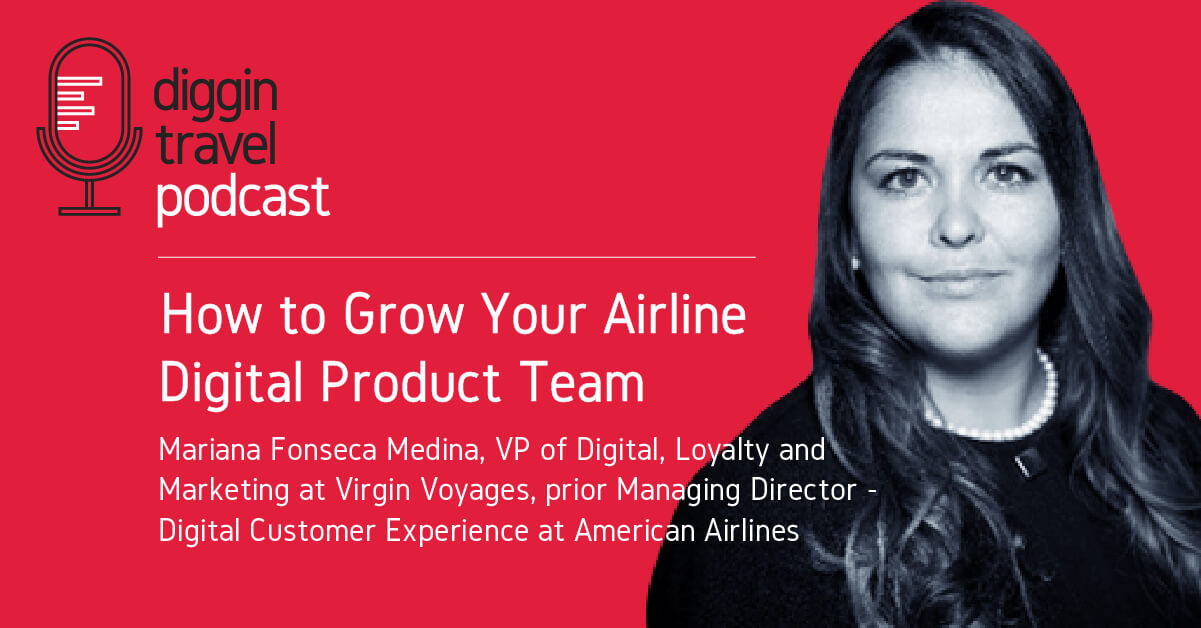Select Sidearea
Populate the sidearea with useful widgets. It’s simple to add images, categories, latest post, social media icon links, tag clouds, and more.


hello@youremail.com
+1234567890
+1234567890
Populate the sidearea with useful widgets. It’s simple to add images, categories, latest post, social media icon links, tag clouds, and more.


Iztok Franko

I’ve wanted to have this chat about how to grow your airline digital product team for a long time. Why?
Because many times I get this question from airline digital leaders: “Where do we go from here? How do we grow our digital team to do things faster and at larger scale?”
To give you some of the answers, I talked to an experienced digital leader who has plenty of experience on this topic. Mariana Fonseca Medina has upscaled digital teams in a large airline organization environment at American Airlines, and she built one almost from scratch in a start-up setting at Virgin Voyages.
Listen to the new episode of the Diggintravel Podcast about how to grow your airline digital product team via the audio player below, or read on for key highlights from our talk with Mariana:
And don’t forget to subscribe to the Diggintravel Podcast in your preferred podcast app to stay on top of airline digital product, analytics, experimentation, user research, innovation, and other trends!
Before we jump into how to grow your airline digital product team, let’s first address one important thing: digital product metrics. If you want to grow your team and build digital products at scale, you need to know how to measure your progress. And that requires defining proper metrics. Here’s Mariana’s take on how to define proper metrics for airline digital products:
I would say you have to measure what you can influence. This is where sometimes, digital OKRs and business level objectives are not 100% aligned. I think every CEO would like to say, ‘I have a revenue goal of doubling bookings, and I need your OKR to be doubling bookings.’ Well, the people responsible for the checkout page cannot influence doubling bookings. They can influence doubling the throughput of people paying on that page or reducing the number of errors on that page.
Mariana highlighted two things that you need to consider when you’re defining your digital product OKRs:
It’s finding that sweet spot and creating objectives and key results of things that you can influence that correlate or tie into the broader business objectives, but not falling in the trap of two things. One is adopting those business objectives as your digital OKRs, because you’re never going to be able to measure success. If I commit to doubling bookings, then all I can do is, I don’t know, change the forms, improve the UX, remove some error rates. I’m not going to be able to accomplish my goal. A goal that cannot be accomplished should not really be a goal.
The other thing that you should avoid is the opposite: having objectives and key results of things you can measure, but that actually don’t contribute at all to the revenue targets, or to whatever the overall corporate targets are. If I have a goal of decreasing time on task, but time on task doesn’t necessarily mean more revenue, better conversion, or higher attachment, then I am not contributing to that corporate goal.
That for me is the biggest learning. It’s tough because purist digital product managers want that metric that they can tackle, and they may not be seeing the corporate goals. And then business leaders who are not digital native only want the business goal, but they don’t understand that the digital product teams can only influence so much. It’s finding that negotiation and balance between the two.
During her time as a Managing Director of Digital Customer Experience at American Airlines, Mariana was involved in a big digital transformation project, part of which was about how the American Airlines digital teams were organized.
I was very fortunate that during my time at American, we went through a massive digital transformation, trying to move away from distributed teams – teams that basically took care of – call it a platform or a type of technology. There was someone that did the common services, and there was a team that did website stuff and app stuff, more around the platform. We actually transitioned to product teams that were more aligned to OKRs.
Mariana emphasized the importance of having proper metrics if you want “productization” to work:
All of these learnings around how to set proper OKRs and establish teams actually came from that long and difficult time, but ultimately, in my opinion, one of the most successful implementations of productization that I’ve seen. It’s a good hybrid for a super large company of having product teams – that is, teams whose only responsibility is to be the most effective at shopping and buying, for example – with technology teams focused on supporting shopping and buying for them, where they can have a dedicated backlog and teams and they can become really fast and nimble in delivering.

The last thing Mariana mentioned is that having a dedicated backlog is crucial. If you want to make your digital product focused organization work, having a dedicated backlog for each of the products is key for building and optimizing several digital products at the same time.
Mariana shared an example of the American Airlines seat map digital product, which was their pilot case for the new way of working and organization.
It started with pilots that we did maybe four or five years ago around very small products just to see how it would work. We took a team that would only work on the seat map, which sounds like a lot, but if you think of companies like Booking.com, they have full teams just working on one widget within the home page. So a team working on the seat map wasn’t so bad.
So you had a full team, you had dedicated product designers or UX resources, you had dedicated engineering resources, and then obviously you had a dedicated product owner, and they had a backlog. They said, ‘Our number one goal is to drive attachment, more people selecting seats.’ Then they did the proper amount of research and understanding what the customer wanted and where the gaps were.
Once they enabled a dedicated product team to decide and work on their own, Mariana and the team saw a big improvement in the amount of time needed to deploy new product features.
That team was able to drive their own features. They didn’t have to check with anybody else. They prioritized the highest things that they thought were going to contribute to value, and then they would deploy when ready. They actually did it with this concept of scheduled weekly or monthly releases, which was great because every time they learned something new – let’s say we have to have a different disclosure for families, another big pain point. Families want to sit together. They would be able to develop it and deploy it within a couple of days.
Coming from an airline that took a really long to do anything, establishing that was quite incredible. Now, they still have to work with a broader ecosystem.
When you transition to a decentralized model, the obvious question is: How do you manage to ensure that all product teams are aligned? Here is where we get back to what we talked about at the beginning, which is defining proper goals and metrics. But Mariana also highlighted another important aspect – leadership.
This gets asked a lot, like people are going to go rogue and build whatever they want. I’m like, isn’t that what leadership is here for, ultimately? We are the checks and balances. If teams do go rogue, then shame on leadership for not sharing what the larger corporate objectives are so that they understand they need to support those – so they’re not going rogue; they should be building their OKRs in support of large corporate objectives.
You do have to create some central structures to support decentralization of product teams and encourage a lot more collaboration than before in a way that’s organic and not forced. But I think all of that is well worth the effort because at the end of the day, you end up having a much better way of working.
There were tons of other interesting things that we talked about with Mariana – comparing digital product in airlines versus cruise lines being among them – so make sure to listen to the full interview via the podcast player embedded in this article or on your preferred podcast platform.
If you want to learn from leaders like Mariana about future travel trends or want to be the first to know when our next Airline Digital Talk will be published, please:
I am passionate about digital marketing and ecommerce, with more than 10 years of experience as a CMO and CIO in travel and multinational companies. I work as a strategic digital marketing and ecommerce consultant for global online travel brands. Constant learning is my main motivation, and this is why I launched Diggintravel.com, a content platform for travel digital marketers to obtain and share knowledge. If you want to learn or work with me check our Academy (learning with me) and Services (working with me) pages in the main menu of our website.
Download PDF with insights from 55 airline surveyed airlines.
Thanks! You will receive email with the PDF link shortly. If you are a Gmail user please check Promotions tab if email is not delivered to your Primary.
Seems like something went wrong. Please, try again or contact us.


No Comments